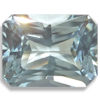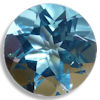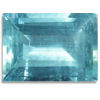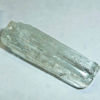
The blue variety of beryl is the birthstone for March. It doesn’t take much knowledge of Latin or Spanish to figure out why it is called “aquamarine” meaning “sea water”. Aquamarines get their color from iron but are only considered aquamarine if their color is blue to green. Other beryls hang at the fringes of aquamarines territory. Greenish beryls that are due to the trace element chromium are emeralds even when they are light and have a distinct blue tint. Green beryls due to trace elements other than iron and chromium are simply called “green beryl”. Even beryls that have iron as their color causing element may not be aquamarines; there are yellow and golden beryls that derive their color from iron. Also, if no blue tint exists in a beryl, this gem is technically called “goshenite”.
The color ranges from extremely pale blue to a rich swiss blue. Stable dark blue color is extremely rare and very expensive. The super high end blue material is called Santa Maria Aquamarine for its source in Brazil. Although there are natural blue aquamarines of this quality, most of the darkest material in the market is enhanced with irradiation. Be aware that irradiated aquamarine’s color is not permanent and will fade over time. Most aquamarines are heat treated however and this enhancement is permanent. Heat treatment is so common with aquamarine that it is expected and normally only discussed if gems are not treated. Unheated gems tend to be more green and silky.
You’ll find many gem dealers offering what they call synthetic or lab aquamarine. This is not beryl, it is actually lab Spinel. That is not to say that blue lab Spinel is not beautiful and an excellent low cost alternative to the fine blue aquamarine. You can get very large sizes and matching with lab Spinel and still get a very realistic color.
Another excellent alternative for aquamarine is blue topaz. Sky blue topaz is almost indistinguishable visually from aquamarine and is usually less than half the price. The lighter blue topaz is either a natural color or just heat treated. The swiss blue topaz is only a satisfactory alternative to the finer aquamarines and that color is created with irradiation. Consider these facts when you’re forced to look at lower cost options for aquamarine.
Aquamarine rough is often found in well formed crystals. Unabraded crystals with good color on matrix are hard to find. Thin, long and light colored crystals are plentiful. These thin crystals are not good for faceting so with just a little work you can find many matched pairs for earringdangles. Chunky clean aquamarine is tougher to find and therefore the driving factor in larger gems demanding a big premium. Aquamarine crystals also tend to have inclusions that propagate the whole crystal on the “C” axis. These inclusions are tough to see before faceting and often lead to lower yields. Sometimes however, these lengthwise inclusions are so consistent that a cabochon in this material will display a nice cat’s eye.




